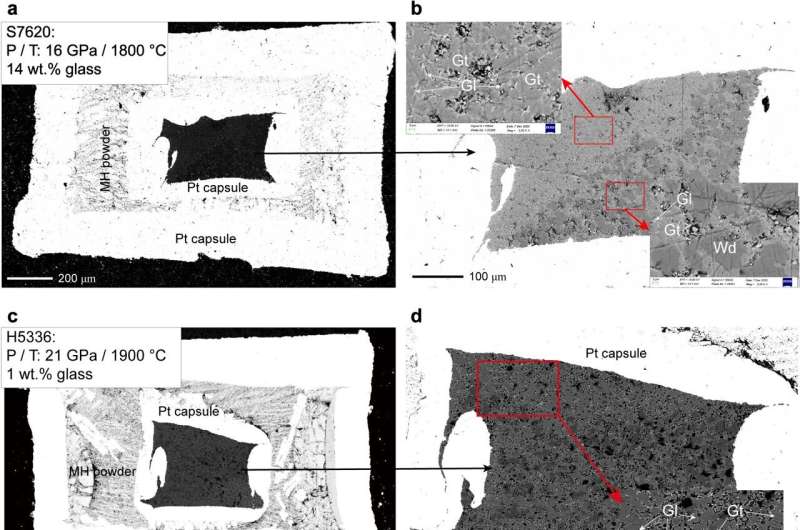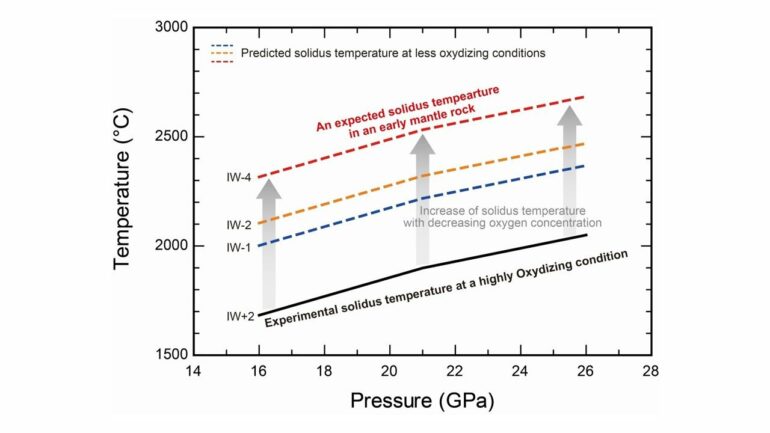It is widely accepted that the early Earth largely consisted of molten magma, forming a global ocean of magma. This extreme state of Earth was likely caused by the intense heat generated from accretionary impacts, meaning the collision of smaller celestial bodies with Earth. Understanding the formation of this magma ocean is crucial for comprehending Earth’s formation.
A major problem with current magma ocean formation models is the lack of consensus on the melting temperatures of deep mantle rocks. Models explaining Earth’s core formation use a specific set of experimental data to estimate mantle melting temperatures, but recent experiments have shown that these temperatures may differ by 200–250 °C from the previously accepted data.
Some studies indicate that oxygen fugacity, or the amount of oxygen available in the mantle, may strongly affect the melting temperatures of deep mantle rocks, which in turn may have influenced the formation of the magma ocean. The mantle’s oxygen fugacity is thought to have increased during accretion, core formation and subsequent mantle evolution; however, the effect of this increase on the melting temperatures of deep mantle materials remains unclear.
Addressing this gap, a team of researchers led by Associate Professor Takayuki Ishii from the Institute for Planetary Materials at Okayama University, Japan and Dr. Yanhao Lin from the Center for High Pressure Science and Technology Advanced Research, China, investigated the effects of oxygen fugacity on magma ocean formation during early Earth evolution.
“The evolution of early Earth has been greatly influenced by oxygen fugacity, which may necessitate the reconsideration of current models. To this end, we assessed the effect of oxygen fugacity on the melting temperatures of deep mantle materials to constrain the conditions at the floor of a deep terrestrial magma ocean,” explains Prof. Ishii.

Representative backscatter electron (BSE) images of the experimental products above the solidus at pressures of 16, 21 and 26 GPa at fO2 = IW+2.0. © Nature Geoscience (2024). DOI: 10.1038/s41561-024-01495-1
The study also involved Professor Wim van Westrenen from the Department of Earth Sciences, Faculty of Science at Vrije Universiteit Amsterdam, the Netherlands, Professor Tomoo Katsura from Bayerisches Geoinstitut, University of Bayreuth, Germany, and Dr. Ho-Kwang Mao from the Center for High Pressure Science and Technology Advanced Research, China. It was published online in the journal Nature Geoscience on July 16, 2024.
The researchers conducted melting experiments at pressures of 16–26 Gigapascals, similar to mantle depths between 470 km and 720 km, at high oxygen fugacities, on mantle pyrolite, a material composition representing Earth’s mantle. Results revealed that over this pressure range, the melting temperatures decreased with increasing oxygen fugacity and were at least 230–450 °C lower than those from experiments conducted at low oxygen fugacities.
Assuming a constant temperature for the magma ocean, this implies that the magma ocean floor deepens by about 60 km for each logarithmic unit increase in mantle oxygen fugacity. This strong influence of oxygen fugacity on mantle melting suggests that current models for early Earth thermal evolution and core formation need re-evaluation.
Furthermore, these results can also explain the apparent discrepancy between the low oxygen fugacities predicted for the Earth’s deep mantle post-core formation and the high oxygen fugacities observed in magmatic rocks over 3 billion years old, formed by melting of the deep mantle.
“Beyond Earth’s formation, our findings on the dependence of melting temperatures on oxygen fugacity can also be applied to understand the formation of other rocky planets that can support human life,” remarks Dr. Lin, highlighting the potential impact of the study. He adds, “For example, these results can improve our understanding of Mars, which is a recent hot topic regarding human habitability.”
More information:
Yanhao Lin et al, Melting at the base of a terrestrial magma ocean controlled by oxygen fugacity, Nature Geoscience (2024). DOI: 10.1038/s41561-024-01495-1
Provided by
Okayama University
Citation:
Uncovering the role of oxygen concentration in the formation of early Earth magma ocean (2024, August 26)



